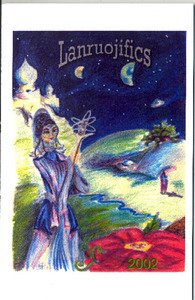
What is AURA? No, not aura, a distinctive atmosphere, or an energy field from a living being, but AURA. AURA stands for the Alfred University Research and Archive. It’s Alfred University’s own digital repository, a place to discover the past and inform the future.
What is a digital repository?
- A means of storing and providing access to digital content (research, scholarship and documents of historical significance)
- Provides a stable, well-managed, permanent archive for digital scholarly and research materials of enduring value produced by faculty, staff, and students
- Supports research, learning and administrative processes
- Includes a wide range of content: research data, meeting minutes, newsletters, theses and dissertations, published articles, technical reports, conference papers, historical information, etc.
For example, this newletter of the Science Fiction Club, Lanruojifics, Fall 2002

What are the benefits of a digital repository?
- Content can be searched full-text, across all documents
- Allows the content to be shared locally and globally
- Allows wide and rapid dissemination of intellectual output, thereby raising awareness of Alfred University to a wider audience
- Stores and organizes the plethora of digital documents created on campus in one place, accessible from anywhere
- Supports a wide range of file types (text, images, video, data sets, etc.)
- Access to content can be restricted as needed
- Required for researchers applying for certain types of federal funding
- Usage can be tracked for statistical purposes
Why not just put this material into Blackboard?
- AURA makes content available to external audiences (open access availability)
- AURA’s content can be indexed by search engine harvesters (such as Google)
- AURA’s content is organized into collections and subcollections
- BlackBoard was designed as a course management system; not a document warehouse. It doesn’t allow for searching across documents and doesn’t manage collections or access to them as well as AURA does.
How can you help to build AURA?
- · Submit your club’s publications and meeting minutes for inclusion in AURA
- · Submit your publications and research to AURA.
- · Submit publications from your program, division, school and college. Help us keep AU’s institutional memory strong in the digital era.
Want to check out AURA right now?
http://aura.alfred.edu
— Steve Crandall